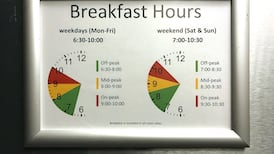After five weeks of restrictions Dr Tony Holohan cautiously announced we had flattened the curve of the coronavirus epidemic with no peak in sight. However, the battle against the false information epidemic is not going so well with no sign of the curve being flattened.
Defined by the World Health Organisation (WHO), an infodemic (information epidemic) is the spread of mostly false information that can erode trust in official information, weaken or eliminate public compliance, and fuel geopolitical tensions.
Covid-19 has provided perfect conditions for an infodemic. It has heightened our risk awareness, created a hunger for real-time information and compromised our decision-making ability.

Scenarios that were usually associated with Hollywood films are now unfolding in real life with the recognition that all information, no matter how crazy it sounds, could in fact be true. Add in the tsunami of information from all platform s and you get an idea of how an infodemic occurs, with distorted realities literally going viral.
There are three main sources of of contagion or “data mutations” in an infodemic:
Disinformation: this is essentially false information that is spread with the sole purpose of causing confusion and harm. This false information is often wrapped in highly engineered messages designed to latch on to our most basic human emotions and then planted on social media platforms to work its way through people's networks at lightning speed.

Misinformation: in the current crisis most misinformation has taken the shape of information that is not complete or taken out of context. The motive is not malicious but can still be harmful. One example of this is the sharing of information about promising yet unproven drugs or Covid-19 treatments. Decisions based on misinformation like this are rarely sound ones.
Amateur analysis: this describes analysis often based on trusted data sets but conducted or presented poorly, leading to misinterpretation. Given there are so many factors that determine how Covid-19 spreads within a region, it has been very hard to generalise the effects seen in one country to the next. We are constantly being exposed to data visualisations presenting pandemic-related data in very innovative ways. Yet many lack details or indeed an explanation of what the data does and does not tell us.
So how do we flatten the infodemic curve?
Just as with Covid-19, we must attack the curve on two fronts (suppress the contagion and increase our capacity to deal with the surge of information we are experiencing). We advise the following:
Fact check (equivalent to good hygiene). A 2018 study conducted by MIT researchers discovered that false stories on Twitter spread faster and more widely than truths. With that in mind, pause a beat before clicking on the share button. Every social media post should be viewed with scepticism prior to conducting your own fact-checking process.
Stick to trusted sources (equivalent to staying at home and physical distancing). Maintain a list of trusted experts can you rely on. Review and adjust as the crisis unfolds. Experts are a great source of information but also a great way to identify other experts. Leverage the network of experts and their ability to curate reliable content.
Do not forward (equivalent to covering mouth and nose if sneezing/coughing). We are the channels that spread the infodemic throughout our networks. If in any doubt of the validity of a message, even if forwarded from one of your close friends, do not pass it on. Even if you think your network contacts are big and strong enough to make up their own mind, there may be people more at risk to these types of malicious messages. Just as with the pandemic, less digitally fluent people find it hard to decipher such messages causing undue stress and harm.
Increase supply of data (equivalent to increasing supply of medical capacity). Finally, in time of uncertainty, we crave explanations and data. In the absence of official data, the public will seek this data elsewhere. However, translating the scientific complexity of tackling Covid-19 into simple actions without undermining accuracy requires a specialist role such as a science communicator to act as a conduit for relevant and reliable data into the overall Covid-19 communication strategy.








